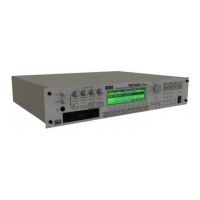96
Master effects
The input levels to the master effects are set by the
“Send Level 1, 2” (step 3 or 8). If “Send Level 1, 2”
are zero, the master effects will not apply. “Send
Level 1” corresponds to MFX1, and “Send Level 2” cor-
responds to MFX2.
0 Select the PROG 7.3: Ed-MasterFX, Setup page.
A In “Master Effect1” and “Master Effect2,” select
the type of each master effect.
The procedure is the same as when selecting an
insertion effect (
☞step 5).
The master effects cannot use double-size effects.
The master effects are mono-in/stereo-out. Even if
a stereo-input effect is selected, it will function as
mono input.
B Use “On/Off” to specify the on/off status of each
master effect.
With a setting of Off, the output of the master effect
will be muted.
C Use “Rtn (Return1, 2)” to adjust the output levels
of the master effects.
In the “W/D” (Wet/Dry) setting of each effect, the
W setting is the effect output level. This value mul-
tiplied by the value of the return setting (i.e., x1.0 if
“Rtn” = 127) to determine the actual master effect
output level.
D Select the MFX1 and MFX2 pages, and set the
parameters for each selected effect.
For details on the parameters of each effect, refer to
PG p.151.
Master EQ
E Use the stereo 3-band master EQ to make final
equalizing adjustments immediately before the
sound is output from the AUDIO OUTPUT L/
MONO and R jacks.
Master EQ settings can be made in “Master EQ Gain
[dB]” of the PROG 7.3: Ed-Master FX, Setup page, or
in the Master EQ page.
For details on master EQ parameters, refer to PG
p.203.
Effect settings in Combination, and
Multi modes
In Combination, and Multi modes, you can specify the
routing of each timbre/track to the insert effects and
master effects. These settings are made in the same way
in each of these modes. We will be using the example of
Combination mode in our explanation here.
Routing
1 Select the COMBI 7.1: Ed-BUS, BUS page.
2 Select “BUS Select.” Here you can specify the bus
(insert effect) to which the output of each timbre
will be sent.
The Routing page displays the status of the rout-
ing, insert effect, and chain settings. In this page
you can also make “BUS Select” settings. Use the
[ ], [ ] keys to select the timbre, and use the
[INC], [DEC] keys to specify the send destination
insert effect.
In this example, T01 (timbre 1) uses IFX1 and 2.
T02 uses IFX2, T03 uses IFX3 and 4, T02 and T05
use IFX4, and T06 and T07 use IFX5. Selection of
each effect type, the on/off setting, and chain set-
tings are made in the COMBI 7.2: Ed–InsertFX,
Setup page.
In COMBI 7.2: Ed–InsertFX, Routing page too, you
can use the [ ], [ ] keys to select the timbre, and
the [INC], [DEC] keys to specify the bus.
3 “S1 (Send1(MFX1)),” “S2 (Send2(MFX2))” specifies
the send level from each timbre to the master
effects.
This can be set only if “BUS Select” is set to L/R or
Off.
The actual send level will be the send level of each
timbre multiplied by the send level of each oscilla-
tor of the program selected for the timbre. If the
send level of a program is 0, the actual level will be
zero even if the send level setting is raised here.
If IFX1–IFX5 is selected for “BUS Select,” set the
send levels to the master effects by adjusting the “S1
(Send1(MFX1))” and “S2 (Send2(MFX2))” parame-
ters (COMBI 7.1: Ed-Insert FX, Setup page) located
after the signal has passed through the insert effects.

